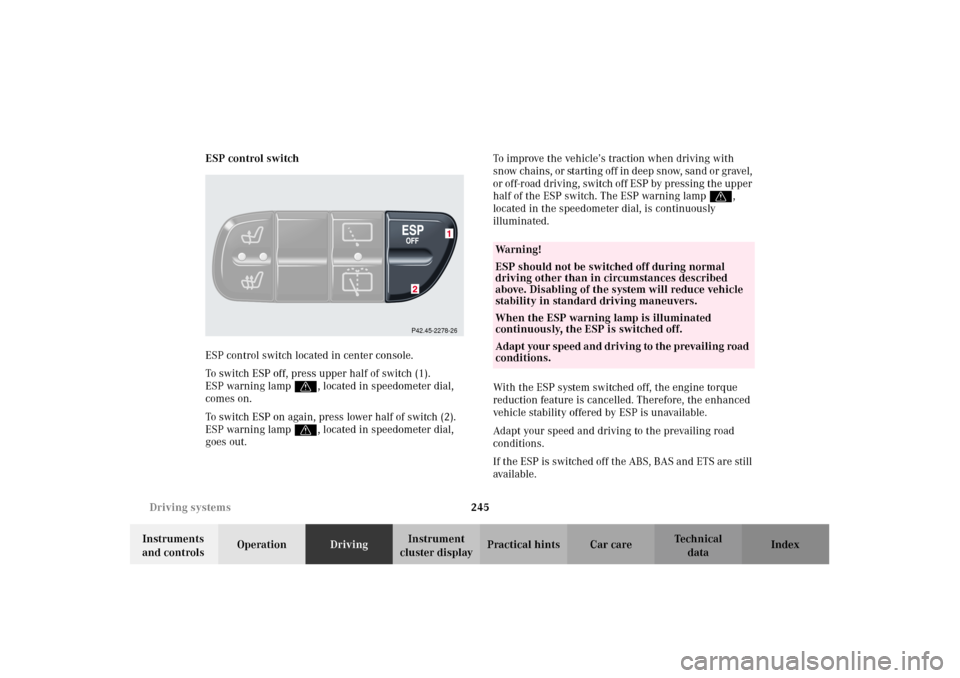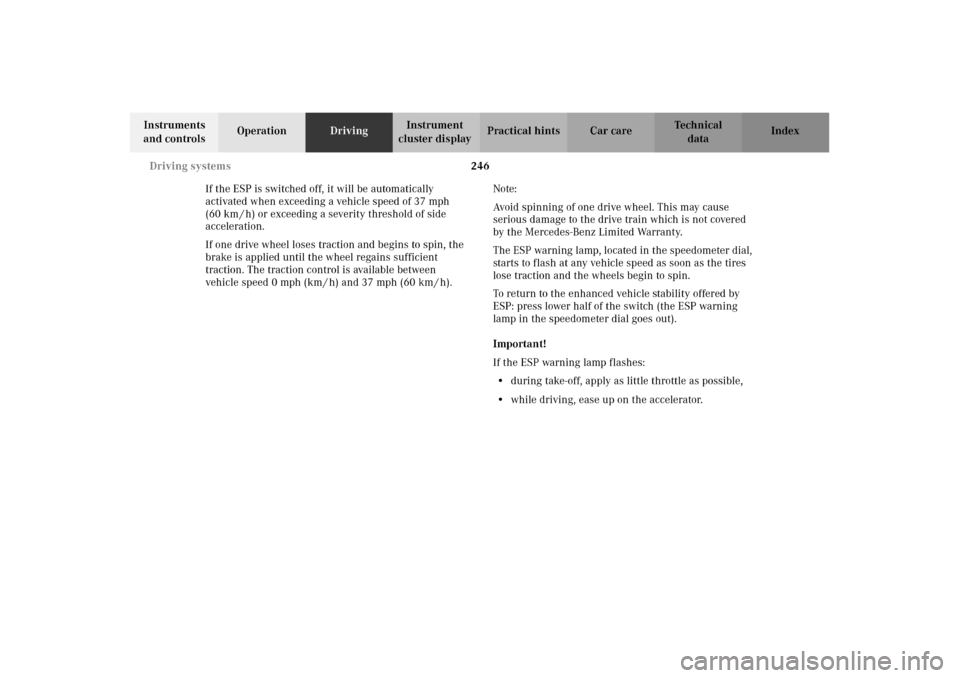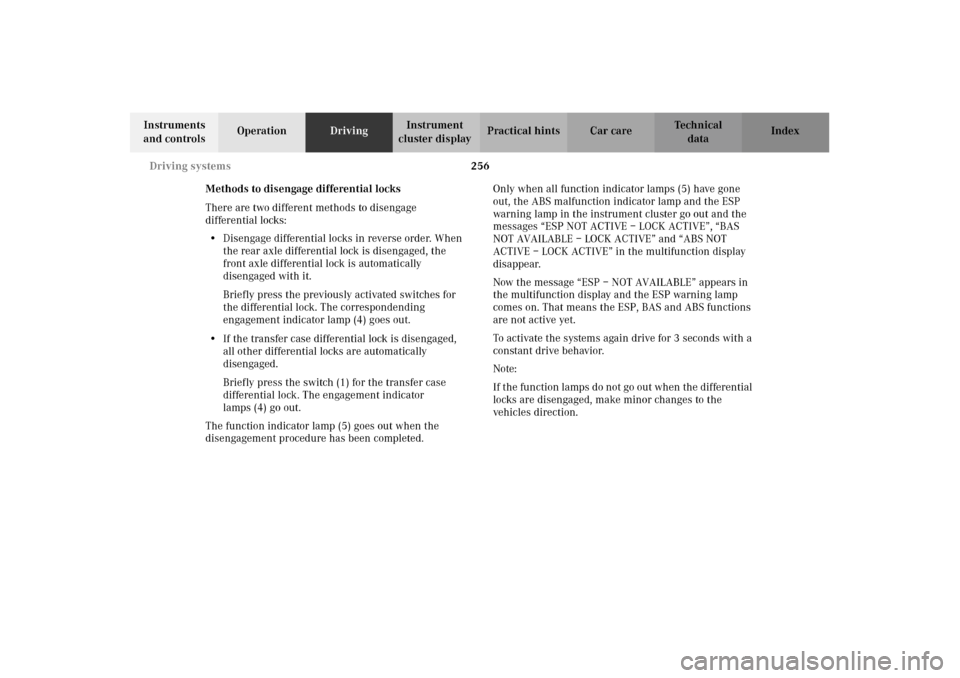Page 248 of 385

245 Driving systems
Te ch n i c a l
data Instruments
and controlsOperationDrivingInstrument
cluster displayPractical hints Car care Index ESP control switch
ESP control switch located in center console.
To switch ESP off, press upper half of switch (1).
ESP warning lamp v, located in speedometer dial,
comes on.
To switch ESP on again, press lower half of switch (2).
ESP warning lamp v, located in speedometer dial,
goes out.To improve the vehicle’s traction when driving with
sn ow chain s, or startin g of f in d eep sn ow, san d o r grave l,
or off-road driving, switch off ESP by pressing the upper
half of the ESP switch. The ESP warning lampv,
located in the speedometer dial, is continuously
illuminated.
With the ESP system switched off, the engine torque
reduction feature is cancelled. Therefore, the enhanced
vehicle stability offered by ESP is unavailable.
Adapt your speed and driving to the prevailing road
conditions.
If the ESP is switched off the ABS, BAS and ETS are still
ava il ab le .
P42.45-2278-26
Wa r n i n g !
ESP should not be switched off during normal
driving other than in circumstances described
above. Disabling of the system will reduce vehicle
stability in standard driving maneuvers.
When the ESP warning lamp is illuminated
continuously, the ESP is switched off.
Ad apt your s peed an d d ri vi n g to the prevai li ng road
conditions.
J_G463.book Seite 245 Mittwoch, 19. September 2001 8:06 08
Page 249 of 385

246 Driving systems
Te ch n i c a l
data Instruments
and controlsOperationDrivingInstrument
cluster displayPractical hints Car care Index
If the ESP is switched off, it will be automatically
activated when exceeding a vehicle speed of 37 mph
(60 km / h) or exceeding a severity threshold of side
acceleration.
If one drive wheel loses traction and begins to spin, the
brake is applied until the wheel regains sufficient
traction. The traction control is available between
vehicle speed 0 mph (km / h) and 37 mph (60 km / h).Note:
Avoid spinning of one drive wheel. This may cause
serious damage to the drive train which is not covered
by the Mercedes-Benz Limited Warranty.
The ESP warning lamp, located in the speedometer dial,
starts to flash at any vehicle speed as soon as the tires
lose traction and the wheels begin to spin.
To return to the enhanced vehicle stability offered by
ESP: press lower half of the switch (the ESP warning
lamp in the speedometer dial goes out).
Important!
If the ESP warning lamp flashes:
•during take-off, apply as little throttle as possible,
•while driving, ease up on the accelerator.
J_G463.book Seite 246 Mittwoch, 19. September 2001 8:06 08
Page 254 of 385

251 Driving systems
Te ch n i c a l
data Instruments
and controlsOperationDrivingInstrument
cluster displayPractical hints Car care Index A few words about differentials and differential
locks
When a vehicle negotiates a turn, wheels on the outside
of the curve must travel farther and rotate faster than
the inside wheels. The differential, the operation of a set
of gears that allow the powered wheels in a vehicle to
turn a different speeds, provides for this essential
function.
The drawback is that the differential also sends most of
the engine's power to the wheel with the least load or
strain on it. For example, if one of a vehicle's powered
wheels sits on a patch of snow and spins because there
is no traction, all of the engine's power will go to that
wheel because the power will take the path of least
resistance. Meanwhile, the opposite wheel, sitting on
dry pavement where it could get enough grip to start the
vehicle moving, sits idle because it gets no power.
The Electronic Traction System (ETS) addresses this
problem and provides for good control and steering
ability by automatically slowing the slipping wheel and
thus increasing the power to the other non-slipping
d rive whee ls to get t he ve hicle m ovin g. The ESP and ETS
in this vehicle feature such intelligent limited-slip
differential technology, ideally suited for on-road and light off-road driving. The position “LOW” of the
transfer case (see pages 247and 226) also enhances
off-road driving capabilities.
More extreme off-road conditions may call for another
cure which is to engage a differential lock, preventing
the differential from operating altogether. This vehicle
offers as standard equipment three differential locks:
front, transfer case (center), and rear. Each can be
engaged simply by pushing a dashboard-mounted
button (see pages 253 and 254 for engaging differential
locks). When the transfer case (center) differential is
locked, half of the engine's power is automatically
distributed to the front wheels and half to the rear
wheels. When the rear differential is locked, power
going to the rear wheels is equally distributed, so that
both rear wheels turn at the same speed and torque.
When the front differential is locked, all four wheels
now turn with equal power and torque. Please be aware
that engaging the differential locks will significantly
reduce steering ability of the vehicle.
J_G463.book Seite 251 Mittwoch, 19. September 2001 8:06 08
Page 255 of 385
252 Driving systems
Te ch n i c a l
data Instruments
and controlsOperationDrivingInstrument
cluster displayPractical hints Car care Index
It is important to understand that during on-road/paved
driving, differentials are absolutely required to provide
essential control and steering ability of the vehicle. The
differential locks, therefore, must not be engaged when
driving on paved roads and should only be used when
and to the extent necessary to negotiate off-road
conditions not addressable by the systems (automatic
ETS, ESP; manual switch position “LOW” of transfer-
case) this vehicle comes equipped with.
J_G463.book Seite 252 Mittwoch, 19. September 2001 8:06 08
Page 256 of 385
253 Driving systems
Te ch n i c a l
data Instruments
and controlsOperationDrivingInstrument
cluster displayPractical hints Car care Index Differential locks
The switch is located in the center console.
1Transfer case (center) differential lock
2Rear axle differential lock
3Front differential lock
4Engagement indicator lamps (yellow)
5Function indicator lamp (red)6 The ESP, BAS and ABS are switched off
The differential locks can only be switched on in the
following sequence.
•Transfer case differential lock
•Rear axle differential lock
•Front differential lock
J_G463.book Seite 253 Mittwoch, 19. September 2001 8:06 08
Page 257 of 385

254 Driving systems
Te ch n i c a l
data Instruments
and controlsOperationDrivingInstrument
cluster displayPractical hints Car care Index
Important!
Do not engage the front axle differential lock when
driving around tight corners as steering ability is
restricted.
When the transfer case differential lock is activated, the
ESP, ABS and BAS are automatically switched off.
The ABS malfunction indicator lamp and the ESP
warning lamp in the instrument cluster come on.
Further appear alternately the messages “ESP NOT
ACTIVE – LOCK ACTIVE”, “BAS NOT AVAILABLE –
LOCK ACTIVE” and “ABS NOT ACTIVE – LOCK
ACTIVE” in the multifunction display.
The differential locks should be engaged when driving
off-road, for example:
•for driving trough water or
•when driving on deep snow, icy or fouled surfaces.
For notes on off-road driving, see page 226.To engage differential locks:
Important!
To avoid damage to the transfer case and differential
locks:
• Engage differential locks only at low speed
(walking speed, not more than 5 mph).
• Do not engage differential locks if the driving
wheels are spinning.
Wa r n i n g !
Never drive on pavement with activated differential
locks.
J_G463.book Seite 254 Mittwoch, 19. September 2001 8:06 08
Page 258 of 385
255 Driving systems
Te ch n i c a l
data Instruments
and controlsOperationDrivingInstrument
cluster displayPractical hints Car care Index Briefly press the switch for the differential lock
required. The corresponding engagement indicator
lamp (4) comes on.
The ESP warning lamp in the instrument cluster comes
on and the message “ESP NOT ACTIVE – LOCK
SELECTED” appears.The function indicator lamp (5) comes on when the
differential lock engagement procedure has been
completed. The ABS malfunction indicator lamp and the
ESP warning lamp in the instrument cluster come on.
Further appear alternately the messages “ESP NOT
ACTIVE – LOCK ACTIVE”, “BAS NOT AVAILABLE –
LOCK ACTIVE” and “ABS NOT ACTIVE – LOCK
ACTIVE” in the multifunction display.
Only apply the accelerator lightly when driving off.
J_G463.book Seite 255 Mittwoch, 19. September 2001 8:06 08
Page 259 of 385

256 Driving systems
Te ch n i c a l
data Instruments
and controlsOperationDrivingInstrument
cluster displayPractical hints Car care Index
Methods to disengage differential locks
There are two different methods to disengage
differential locks:
•Disengage differential locks in reverse order. When
the rear axle differential lock is disengaged, the
front axle differential lock is automatically
disengaged with it.
Briefly press the previously activated switches for
the differential lock. The correspondending
engagement indicator lamp (4) goes out.
•If the transfer case differential lock is disengaged,
all other differential locks are automatically
disengaged.
Briefly press the switch (1) for the transfer case
differential lock. The engagement indicator
lamps (4) go out.
The function indicator lamp (5) goes out when the
disengagement procedure has been completed.Only when all function indicator lamps (5) have gone
out, the ABS malfunction indicator lamp and the ESP
warning lamp in the instrument cluster go out and the
messages “ESP NOT ACTIVE – LOCK ACTIVE”, “BAS
NOT AVAILABLE – LOCK ACTIVE” and “ABS NOT
ACTIVE – LOCK ACTIVE” in the multifunction display
disappear.
Now the message “ESP – NOT AVAILABLE” appears in
the multifunction display and the ESP warning lamp
comes on. That means the ESP, BAS and ABS functions
are not active yet.
To activate the systems again drive for 3 seconds with a
constant drive behavior.
Note:
If the function lamps do not go out when the differential
locks are disengaged, make minor changes to the
vehicles direction.
J_G463.book Seite 256 Mittwoch, 19. September 2001 8:06 08